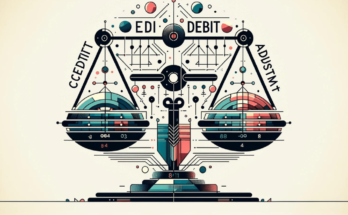Plunge into the frantic world of supply chains where EDI (Electronic Data Interchange) payments hold center stage. Discover how these overlooked but critical ingredients are changing the game in supply chain management. This article reveals the crucial role played by EDI payments as a bridge between disparate countries and cultures, atop the chaos that is market transactions and global business deals. This is how these ‘dark giants’ are essential cogs in the huge supply chain machinery of modern times.
What are EDI Payments?
EDI, or Electronic Data Interchange is the WhatsApp of business transactions. It’s a method for companies to exchange business documents online, in particular the all-important payments process. In other words, you fax or send paper documents around; we do it digitally. That saves time and effort, eliminates errors and reduces costs.
01#Why EDI payments in supply chains?
Accuracy and timing are everything in the realm of supply chains. Networks of manufacturers, suppliers, distributors and retailers spread products around the world. EDI payment make this complex dance smoother in several ways:
- Speed: For example, consider a letter versus an email. Then there is EDI, which e-mails financial transactions; it accelerates the payment process.
- Accuracy: Manual data entry is a bit like playing Telephone, and the errors are just as likely to creep in. Accurate Payment EDI removes this risk.
- Cost-Effectiveness: That means lower costs in paper, postage and processing. It’s like going from cabs to bikes for short city hops—cheaper and often a faster ride.
- Visibility: Tracking payments Just like you track packages, EDI systems allow users to follow their money.

02#The Real-World Impact:
Let’s take an example. U.S.-based clothing retailers source materials from all over Asia. By using EDI payments, it can fast pay suppliers who will then be able to quickly in turn pay their workers and buy materials. This speed and efficiency can It can be the difference between a product arriving on time or missing an entire season in fashion.
Overcoming Challenges
Of course, the switch to EDI payments isn’t just flicking a light. Technology integration, staff training and initial setup costs are among the problems companies have to contend with. But the long-term payoff – cost savings, better relations with trading partners, improved data management are worth it.Read more…EDI payments security Corner of digital transactions.
The Future of EDI Payments:
In future, EDI payments will undoubtedly become even more refined. Advances in AI and blockchain technology mean we can look forward to even safer, more transparent and efficient transactions. It could mean even quicker payments, more effective fraud prevention and even automated decision-making in supply chains.
Enhancing Supplier Relationships
Take business and its suppliers, for example. By adopting EDI payments, this dynamic changes from the traditional transactional model to a more collaborative business partnership. Making timely and accurate EDI payments builds trust, which is the coin of business relationships. Because suppliers are assured of payment on time in EDI, they put greater emphasis onto service and quality.
Streamlining International Transactions:
Currency exchange, differences in banking standards and compliance issues tend to clog up cross-border exchanges in the global economy. By standardizing transactions, EDI payment help negotiate these complexities. This standardization must be vital in turning the tide of international trade, breaking down barriers and opening up new markets for businesses.info…..EDI Payments Reducing Costs and Increasing Efficiency
Environmental Impact:
Sustainability is no longer just a buzzword in today’s business world. Thus, EDI payment help companies achieve their environmental objectives by minimizing paper-based transactions. But it is a small, but important step towards the development of an environmentally sustainable business model.
Empowering Small and Medium Enterprises:
Cash flow management is a particularly pressing problem for small and medium-sized enterprises (SMEs). EDI payments provide a lifeline for these businesses. They get paid faster and can keep better control over their finances than in the past, he says. This is especially true in developing economies, where SMEs are often the very foundations of a nation’s economy.
The Challenge of Standardization:
But even though EDI payment offers many advantages, the absence of common standards is one problem. Because EDI formats vary by industry and region, there may be compatibility problems. But these differences are being addressed by ongoing efforts within international standards organizations. This will open the way for even wider use of EDI payments.Get info ….Types of EDI Payments
03#Harnessing Technology for Competitive Advantage EDI payments:
Integration with Emerging Technologies
The convergence of EDI payment with two emerging technologies, namely blockchain and the Internet of Things (IoT), in this increasingly digital age holds promise. In a future world, if smart contracts could automatically make payments when confirmation of delivery by one or more IoT device is received (thus reducing yet further the delay between sale and payment), then trust across trade partners would naturally increase even further.
Big Data and Analytics
EDI payments yield a lot of information, and when tapped the right way it can be tremendously illuminating about market trends, spending habits and supply chain management. This data can be used to guide decisions, forecast changes in the market and strategize according to changing consumer trends.
Customization and Flexibility
There is no one fits all in the field of supply chain management. The future of EDI payments lies in its flexibility to work with businesses of different sizes and sectors, all with their own unique needs. Customizable EDI payments solutions allow companies of all sizes, from the tiniest local businesses up to multinational corporations, to customize their environment and streamline working procedures in line with actual use.
The Human Element:
Technology is certainly important, but the human element remains indispensable. Adapting and training can be difficult, but it opens up the opportunity for development of skills and creativity. Those firms that invest in their staff, making sure they are able to handle new technologies such as EDI payments will obtain higher returns not only on efficiency fronts but also innovation.

04#Building a Resilient Supply Chain EDI payments
Risk Management:
In this unsafe world, where supply chains have many potential points of failure (from natural disasters to political upheaval), EDI payment add a last measure of certainty and stability. They also allow faster, more precise transactions that help businesses respond rapidly to unexpected events and avoid disruptions.
Supporting Global Trade:
EDI payments are a monument to the help technology offers global trade and its ease. By simplifying and ensuring international transactions, they allow firms of all sizes to enter the global marketplace. This not only stimulates local business activities but also encourages economic growth and development around the world.
A Step Towards Digital Transformation:
But embracing EDI payment is not just an operational makeover; it’s a step towards wider digitalization. It points to a new way that businesses view and manage their operations, with technology and data at the core of decisions about where they are going.more detail EDI Payments a Game Changing Innovations
05#Conclusion:
In a nutshell, EDI payments are much more than mere financial instruments. They act as the butter which greases supply network wheels of efficiency and sustainability around the world. EDI payment standardize transactions today and shape a future of global commerce By cutting red tape, making clear who’s responsible for what, and building up trusted business relationships. But looking ahead, if companies want to keep up with this progressively connected and digitized world they must embrace EDI.




